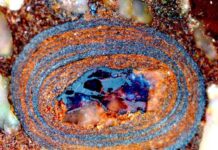[ad_1]
Researchers at Tohoku University in Japan have identified the gene related to the greenish flower mutation in the Habenaria orchid.
Associate Professor Akira Kanno and PhD candidate Mai Mitoma have discovered that the greenish flower mutation is caused by a retrotransposon insertion in one of the floral homeotic genes in the Habenaria orchid. The modification of this gene by a genetic transformation system enables the development of greenish flowers in orchids and other plant species.
Orchids are important ornamental plants with high commercial value. The orchid lip, which acts as a landing platform for pollinators (insects) can vary in shape, form and color. At the center of the flower, an orchid has a unique reproductive organ called a column. Botanists have been interested in the shape of the orchid flower for a long time, however, until now the molecular mechanism of the orchid flower development has been largely unclear. Being able to modify orchid floral structures through genetic engineering would be very valuable for orchid breeders allowing for an increase in orchid production.
Kanno explained the process, which was undertaken to reveal the mechanism: “first, we used a mutant orchid cultivar with greenish flowers to analyze the important genes related to flower development in orchids. Then we found the retrotransposon insertion in one of the floral homeotic genes called the SEPALLATA-like gene in the mutant orchid cultivar.”
This mutant cultivar has greenish flowers. The loss-of-function of the SEPALLATA-like gene transformed the white petals to greenish organs and the column was converted into greenish leaf-like organs; revealing that the SEPALLATA-like gene is essential for petal, lip and column development in orchids.
In the future, the team aims to modify the SEPALLATA-like gene in other orchid species. It is thought that the reduced expression of the SEPALLATA-like gene may produce greenish flowers. These transgenic plants may help us to better understand the molecular mechanism of floral development in orchids.
Story Source:
Materials provided by Tohoku University. Note: Content may be edited for style and length.
[ad_2]















